As an Amazon Associate, we earn from qualifying purchases with no additional costs for you.
A lanyard on a knife has several purposes, and some knife owners love them, others hate them, and others are unsure about why a lanyard should be added to a knife and what its purpose is on a knife.
A lanyard on a knife can benefit safety, grip, accessibility, and storage and prevent you from losing your knife. Lanyards can be used on fixed-blade knives and pocket knives of varying sizes. The lanyard can be made from paracord, leather, or any other suitable material and can be a loop or a fob.
If you are undecided about whether a lanyard is a good idea or not and how to use one properly, we will give you some reasons why a lanyard is a good idea in some cases. We will also offer some ideas on what type of lanyard you should put on your knife and how to use the lanyard.
If you are interested in checking out the best knife with a lanyard hole, we recommend buying KA-BAR Becker BK2 (fixed blade) and Spyderco Para 3 (pocket knife). You can find them by clicking here and here (Amazon links).

What Is The Purpose Of A Lanyard On A Knife?
A lanyard is a somewhat controversial attachment to a knife since some people see it as an item that will get in the way when using the knife, making it unsafe. Others feel that the lanyard is an appropriate accessory for certain knives and can create a safer way to use the knife.
We will explain the reasoning behind why a lanyard can be a good idea and the right way to use a lanyard. We will also discuss some of the reasons a lanyard on a knife is not a good idea. When you have all the information, you can decide if a lanyard is suitable for your knives and the best lanyard choice for each type of knife.
The purpose of the lanyard largely depends on the type of knife the lanyard is tethered to and can include the following.
1. A Lanyard Can Increase Knife Safety
In some knife uses it is possible for the knife to slip out of your hand and injure you or go flying out of your control and injure a bystander.
These accidents are possible when a knife is used for heavy-duty purposes requiring force. When excessive force is applied when using a knife, there is the potential for the user to lose control of the blade.
The lanyard tethers the knife to the user’s wrist or hand, offering greater control over the knife in heavy-duty tasks and preventing the knife from going far should it slip out of the user’s hand.
The tasks where a lanyard is suitable would be where an outdoor knife is used to baton firewood, trim branches, or used to cut through a tough item that requires force.
Another safety aspect favoring a lanyard on a knife is when using the knife in slippery conditions. Working in wet conditions, such as on a boat or processing meat, where the knife handle and your hands can become wet with water, blood, or other slippery substances, the knife can slip out of your hand.
Working in these conditions makes a lanyard an important safety measure to keep the knife safely under control.
2. A Laynard Can Extend The Grip On A Knife
Smaller knives, such as pocket knives and smaller utility knives, have smaller handles. A smaller handle can make a knife more difficult to use for certain tasks.
Lanyards intended for this purpose are usually shorter and include a fob. The fob on the lanyard increases the diameter of the lanyard, making it easier to grip in the hand.
The fob section of the lanyard is usually closer to the knife’s handle than the end of the lanyard. This positioning serves to provide additional grip on short-handled knives.
3. A Lanyard Can Prevent A Knife From Getting Lost
A lanyard that loops around your wrist or that can be attached to your belt can help secure the knife when working in a precarious position.
If you use the knife in an elevated position, such as on a ladder, in a tree, or where there is a significant drop, securing the knife with a lanyard will save the knife should you lose your grip on the handle.
Dropping the knife from such a height can damage the knife, injure someone below you, or the knife can get lost.
Another precarious working position where you have the potential to lose your knife is working with the knife over water. Most fishermen will have a story about losing a knife to the depths of the water because the knife was not secured with a lanyard.
A lanyard clipped to a belt loop, toolbelt, or backpack can prevent the knife from falling out of your pocket or your backpack without you realizing it and becoming lost.
A brightly colored lanyard can also increase the knife’s visibility, making it easier to find and less likely to be left behind once you are finished using it.
The bright colors will catch your eye and remind you to stow your knife in your pocket or gear before leaving your campsite, job site, or other location where you were using the knife.
4. A Lanyard Provides Easy Access To Your Knife
A lanyard attached to your knife can make it more accessible from a pocket or a backpack. Many pocket knives come with clips to attach the knife to the upper edge of your pocket.
Smaller pocket knives and knives of certain designs, such as Swiss Army knives, often do not have these clips but have a lanyard hole. A lanyard with a fob can be attached to the pocket knife to keep it at the top edge of your pocket if the fob is left protruding from the pocket.
This lanyard type prevents the pocket knife from slipping down to the bottom of the pocket, causing you to scratch around in the depths of your pocket to retrieve the knife when needed. To extract the knife from your pocket, simply grab the fob sticking above the edge of the pocket and pull the knife out.
A lanyard can also be used similarly if you are stowing a knife in a backpack. Leave the lanyard protruding above the edge of the backpack or backpack pocket to easily pull the knife from the pack when needed. If the lanyard is clipped to a secure point on your backpack, it makes it easier to find the knife in the dark.
5. A Lanyard Can Be Used To Store A Knife
A lanyard can be a convenient and useful method of storing a knife or positioning it where it will be easy to access.
A hook or a nail in a convenient position allows you to hang the knife by the lanyard, where it will be safely out of the way but still easily accessible when needed. Hanging the knife this way is made easier if a clip, such as a carabiner or a loop, is attached to the lanyard.
Haning the knife by the lanyard can keep the knife off your work surface, preventing the knife from being damaged or preventing an injury when you rummage around on your work surface looking for the knife you just put down!
This storage method for a knife has applications in campsites, kitchens, workshops, or even out in the field, such as hunting. Hang your skinning knife from a convenient branch so that it is accessible and you don’t lose it in the brush while field-dressing the animal.
What Is A Lanyard Hole On A Knife Used For?
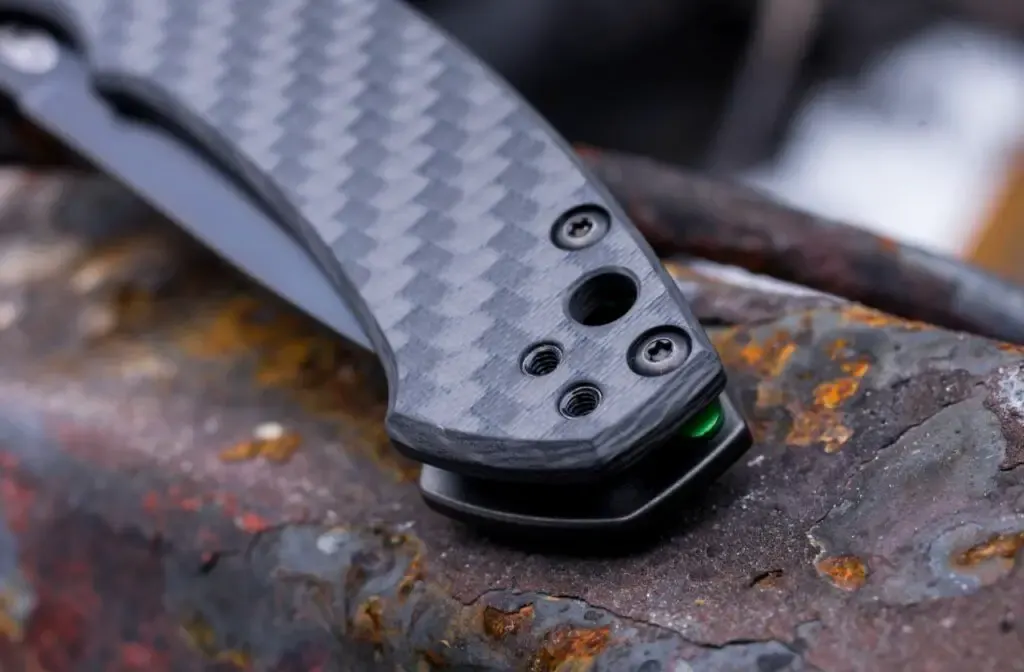
Many knife models feature holes, rings, or clips which can be used for attaching a lanyard. The purpose of the lanyard hole is to provide a suitable securing point that will attach the lanyard to the knife.
The lanyard hole is usually positioned near the back of the knife handle in a location where it will not interfere with the normal grip of the knife under normal conditions.
Where the intention for the lanyard is to improve the grip on small-handled knives, the hole is positioned where the lanyard will be gripped by the last two fingers and the edge of the palm of your knife-hand.
TIP: However, some knives experience difficulties opening and closing, either when they are new or used over time. Check out the complete guide on how to fix these issues in the article below:
How To Fix Guide: Open & Close A Pocket (Swiss Army) Knife
Why Put (Use) A Lanyard On A Knife
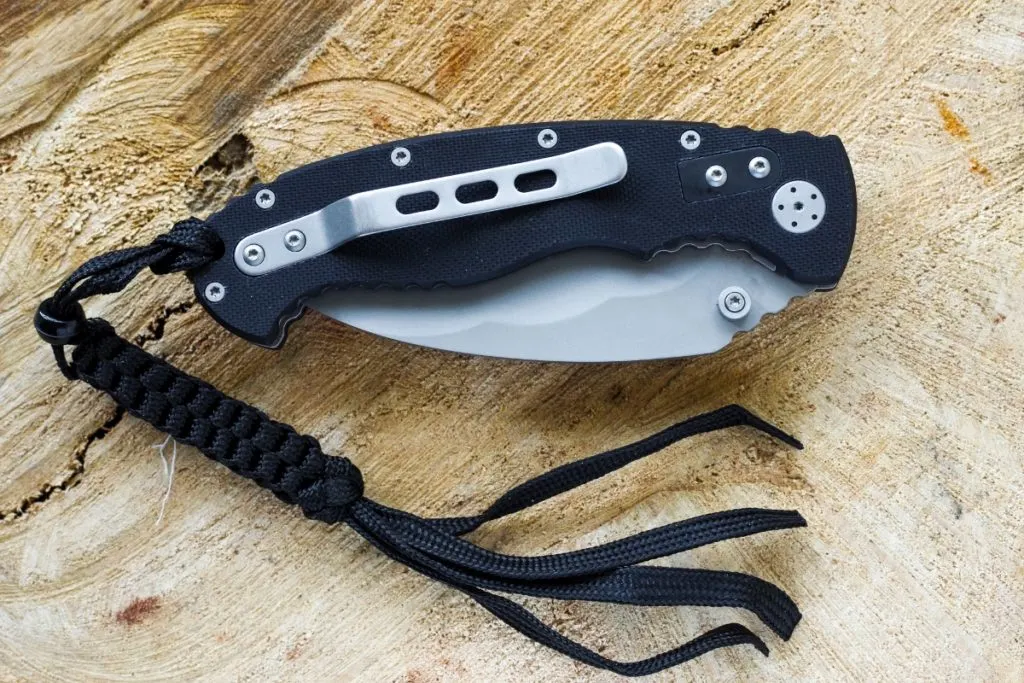
The main reasons to put a lanyard on a large knife are to improve safety when using the knife for heavy-duty functions, prevent the loss of the knife, increase accessibility, or store the knife.
Most knives intended for heavy-duty work will have a lanyard hole on the handle to fit a lanyard. Most of these knives do not come with a lanyard but offer the option to connect one if you prefer to use the knife this way.
The type of lanyard typically used on larger knives is a lanyard with a loop large enough to be slipped over your hand and positioned around your wrist. This type of lanyard keeps the knife on a short leash, so to speak, and prevents it from going far if it slips out of your hand.
Another lanyard type is one that has a thumb loop. The lanyard is wrapped around the back of your knife hand, and your thumb is hooked through the thumb loop at the end of the lanyard.
There are downsides to having a lanyard on your large knives, which require awareness when using a knife with a lanyard attached. Lanyards can get caught up in tools and machinery or hook on objects when you least expect it.
Weak or worn lanyards can break at crucial moments, catching the knife user by surprise and causing injury. Another possibility for injury is a sharp knife dangling from a lanyard when it slips out of your hand.
Despite these potential problems with lanyards, using a lanyard in certain circumstances makes more sense than not using one at all. The main point to consider is that a lanyard is not a failsafe safety item allowing a knife to be used irresponsibly; always respect your knife.
BTW: If you want to know more about Japanese and other knives and their sharpening, check out the books listed above. These books are recommended by professional sharpeners and knife makers (Amazon links):
- Japanese Kitchen Knives: Essential Techniques and Recipes
- The Knifenerd Guide to Japanese Knives
- Knife: The Culture, Craft, and Cult of the Cook’s Knife
- Sharp: The Definitive Introduction to Knives, Sharpening, and Cutting Techniques, with Recipes from Great Chefs
Why Put (Use) A Lanyard On A Pocket Knife
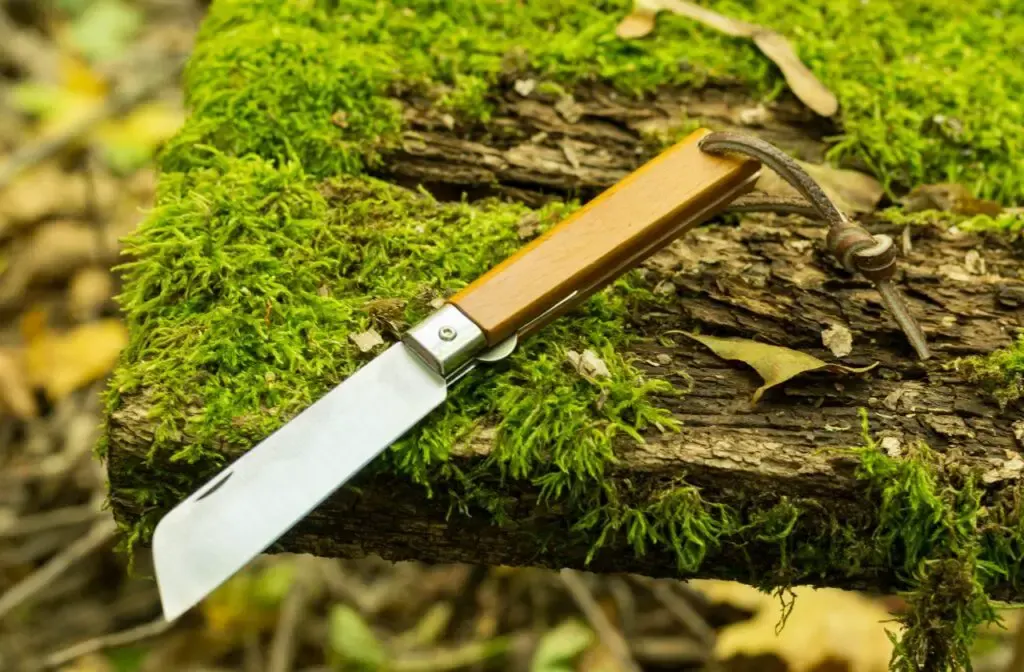
The main use for a lanyard on a pocket knife is for accessibility in your pocket and to extend the relatively shorter handles of these knives.
The lanyards on pocket knives are typically fob-type lanyards rather than the type that can be slipped over the wrist, although there is nothing to prevent you from fitting such a lanyard to your pocket knife.
A lanyard on a pocket knife may be useful, but there are also some possible downsides to fitting one to your pocket knife.
A pocket knife with multiple blades or tools that open to both ends of the pocket knife can be difficult to open on the end of the knife where the lanyard is attached. The lanyard can also make it more difficult to open the knife quickly, especially in an emergency.
Most of these lanyard problems can be overcome by fitting the right type of lanyard to the right knife.
TIP: You may have your pocket knife with you at all times, but you may not have sharpening tools with you at all times to keep your knife sharp. Check out how to sharpen a pocket knife in the article below:
6 Best Ways: Sharpening A Pocket Knife With & Without Stone
How To Put A Lanyard On A Knife
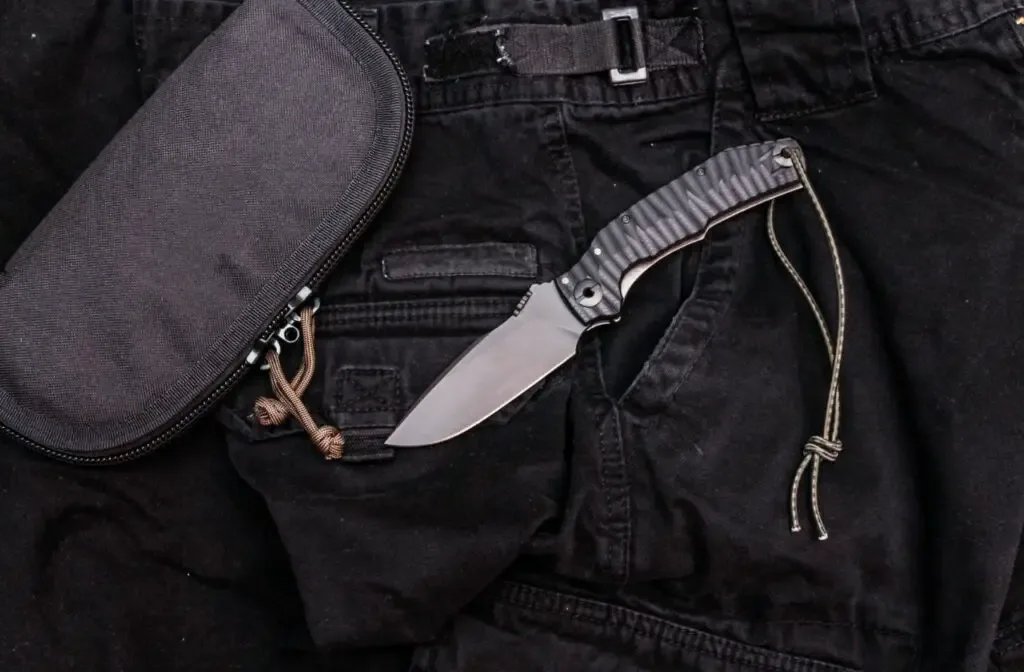
A lanyard can be attached to a knife in various ways depending on the lanyard hole and type of lanyard. Some lanyard holes are large enough to fit the lanyard material directly through the hole or to clip a carabiner through the hole.
If the lanyard hole has a narrower diameter, a keychain ring can be passed through the lanyard hole the lanyard attached to the keychain ring.
Knife lanyards can be made from various materials, including paracord and leather. Many knife owners like to make their own lanyards so they can be customized to the knife owner’s preferences.
How To Make A Pocket Knife Lanyard
Pocket knife lanyards are usually the fob-type lanyard to increase the grip on the knife’s handle or keep the knife accessible in a pocket.
Consequently, most of these lanyards are woven from paracord or leather strips to increase the diameter of the fob and its effectiveness.
You can use many elaborate weaving designs to make your pocket knife lanyard unique and distinctive. For many knife owners, making their own lanyards has become a hobby.
TIP: Many knives are produced with a blackened blade, while others blacken or darken over time. How is this blackening process achieved on the steel? Find out more in the article below:
3 Proven Ways On How To Blacken A (Stainless) Knife Blade
Knives With A Lanyard Hole
Many knives come with lanyard holes included as part of their design, and even if you do not normally use a lanyard, it is useful to have a knife that gives the option.
While you may not normally use a lanyard, you may occasionally need to fit a lanyard to the knife for certain uses temporarily.
Fixed Blade Knife With Lanyard Hole
A suitable example of a fixed-blade knife that can be used for heavy-duty outdoor tasks and chores is the KA-BAR Becker BK2 Campanion (Amazon link) which has a generous lanyard hole in the base of the handle.
The lanyard hole gives the ability to fit a sturdy lanyard to secure the knife around your wrist while batoning kindling, field-dressing game, or securing the knife in a backpack.
The blade of the KA-BAR companion is made from 1095 steel, which gives a good combination of durability and edge retention. The KA-BAR is an American-made classic with all the features required for a robust outdoor knife.
If you are interested in buying the KA-BAR Becker BK2 fixed-blade knife, check out the latest prices on Amazon.
Pocket Knife With Lanyard Hole
Some pocket knives come with pocket clips, and some with lanyard holes. Many pocket knife manufacturers have begun including a pocket clip and lanyard hole in their designs to offer choice and versatility on their knives.
One such knife that we highly recommend is the Spyderco Para 3 Maxamet Pocket Knife (Amazon link), which features a stainless steel pocket clip and a lanyard hole in the handle. The pocket clip can be completely removed in favor of a lanyard, or you can add a lanyard and leave the pocket clip in place to have both options available.
The lanyard hole has a wide diameter to facilitate lanyard material of various thicknesses or clipping a small carabiner directly to the knife. The lanyard can then be clipped onto the carabiner.
Para 3 is a lightweight knife featuring a blade made from high-performance Maxamet steel with a full flat grind for edge durability and easy sharpening.
If you are interested in buying the Spyderco Para 3 Maxamet pocket knife, check out the latest prices on Amazon.
Understanding Different Lanyard Materials and Their Benefits
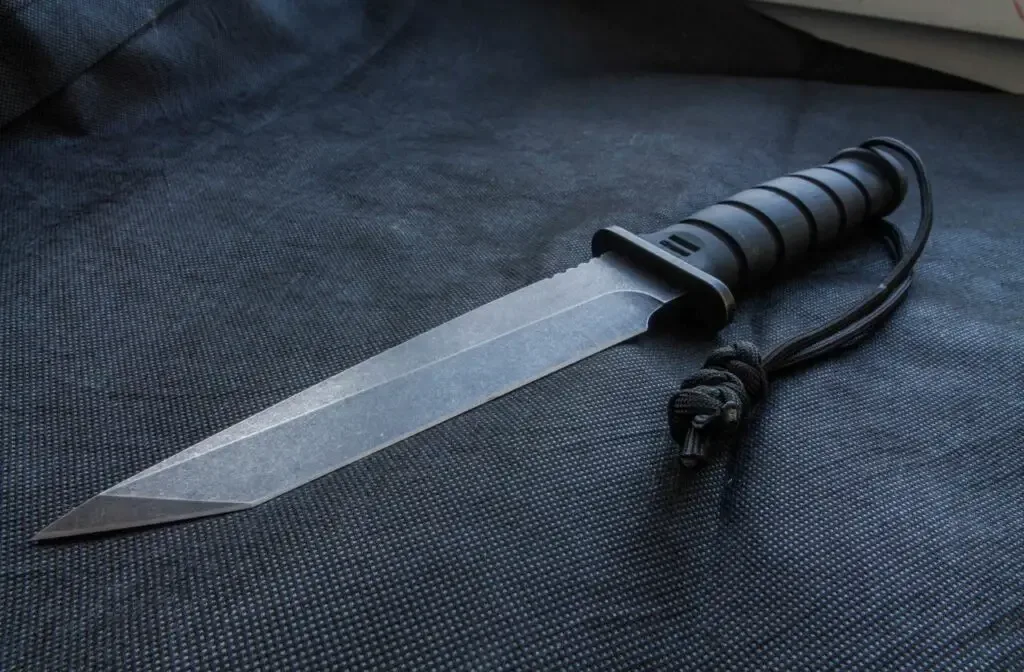
While the concept of using a lanyard on a knife is straightforward, the choice of material can significantly impact its functionality and user experience. In this section, we delve into the most popular materials used for knife lanyards and discuss their unique benefits and potential drawbacks.
Paracord: The Versatile Choice
Paracord, or parachute cord, is a very lightweight nylon rope known for its remarkable strength and versatility. Originally used in parachute lines, it’s a popular choice for knife lanyards due to its durability and the variety of colors available.
Benefits:
- Strength and Durability: Paracord can withstand heavy use and tough conditions, making it ideal for outdoor activities.
- Versatility: Apart from securing your knife, paracord can be unraveled and used in emergency situations, such as for tying up gear or even in first aid.
- Customization: Available in a myriad of colors and patterns, paracord allows users to personalize their knife lanyards.
Leather: The Classic Elegance
Leather lanyards offer a blend of traditional aesthetics and functionality. They are particularly favored by those who appreciate a classic look and feel.
Benefits:
- Aesthetic Appeal: Leather adds a touch of elegance and is often chosen for its classic, timeless appearance.
- Comfort: Leather is gentle on the skin and can be more comfortable for prolonged use.
- Durability: High-quality leather is durable and can age beautifully over time.
Beaded and Metal Lanyards: The Artistic Touch
For those who view their knives as more than just tools, beaded and metal lanyards provide an opportunity to turn a knife into a piece of art.
Benefits:
- Personal Expression: Beads and metal elements offer endless possibilities for personalization and artistic expression.
- Unique Designs: From intricate patterns to simple, elegant designs, these lanyards can complement the style of the knife and its user.
- Durability with Style: Metal components add durability and can complement both modern and traditional knife designs.
Synthetic Fibers: The Modern Alternative
Synthetic fibers, including materials such as nylon or polyester, are also used in lanyard making. These materials are known for their resistance to water and mildew, making them suitable for use in various environments.
Benefits:
- Water Resistance: Ideal for use in wet conditions, synthetic lanyards don’t absorb water and dry quickly.
- Variety of Colors: Like paracord, synthetic lanyards come in various colors, allowing for personalization.
- Lightweight and Durable: These materials are lightweight yet strong, offering a good balance of comfort and durability.
Conclusion
Choosing the right material for your knife lanyard depends on your personal preferences, the environment in which you’ll use the knife and the aesthetics you prefer.
Whether you choose the rugged durability of paracord, the classic elegance of leather, the artistic flair of beads and metal, or the practicality of synthetic fibers, each material brings its unique set of benefits to your knife experience.
Conclusion
While some people do not like using a knife with a lanyard, there is certainly a significant benefit to having a lanyard on your knife in certain circumstances.
A Lanyard can make a knife easier and safer to use, which is often the persuading factor that causes knife users to favor adding a lanyard to their knives!
TIP: Victorinox Swiss Army Knives have a big reputation, but other knife manufacturers in the pocket knife and multi-tool sector produce knives of equivalent quality and usefulness. Find out more in the article below:
Best Victorinox Swiss Army Knife Alternatives You Should Try
